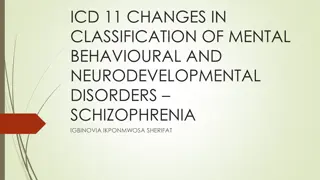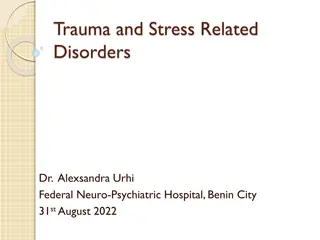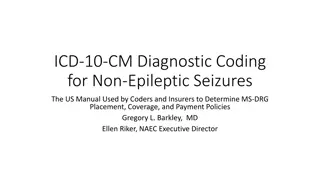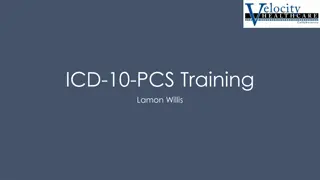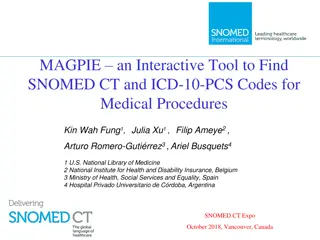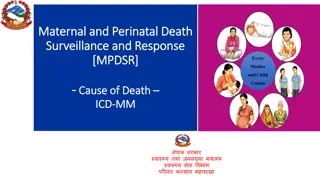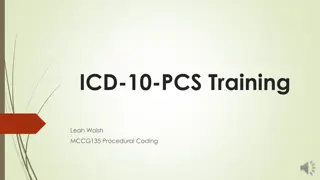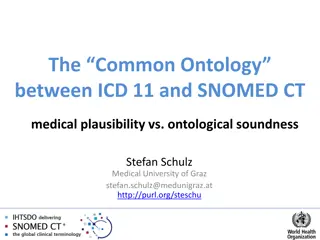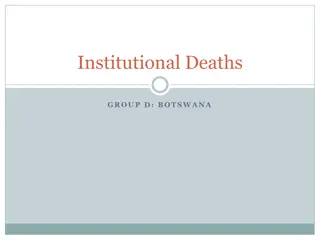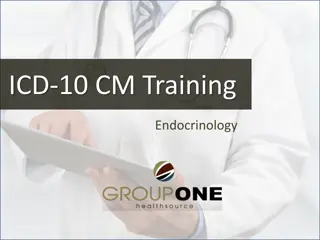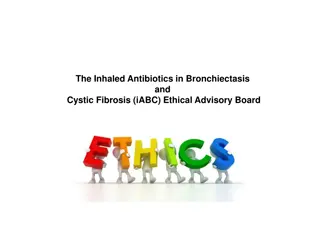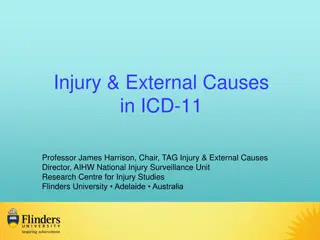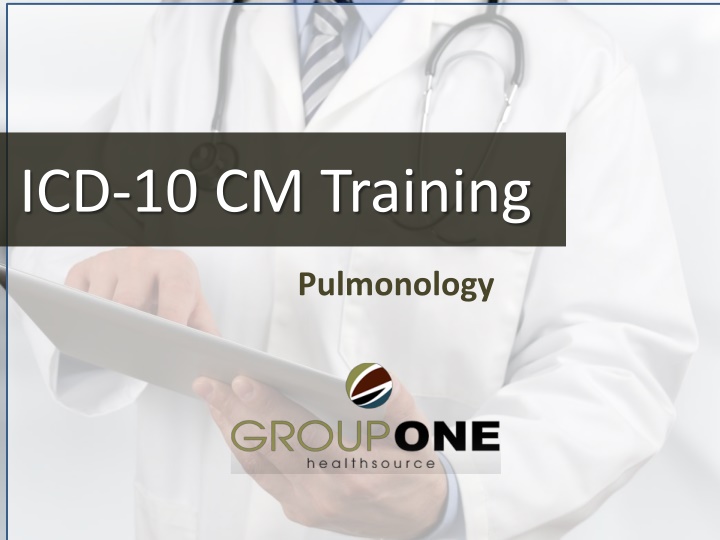
ICD-10-CM Coding Structure and Guidelines
Explore the key aspects of ICD-10-CM coding, including compliance dates, covered entities, code structure, placeholders, 7th characters, laterality, and other codes. Prepare for accurate medical coding with insights into the nuances of the ICD-10-CM system.
Download Presentation

Please find below an Image/Link to download the presentation.
The content on the website is provided AS IS for your information and personal use only. It may not be sold, licensed, or shared on other websites without obtaining consent from the author. If you encounter any issues during the download, it is possible that the publisher has removed the file from their server.
You are allowed to download the files provided on this website for personal or commercial use, subject to the condition that they are used lawfully. All files are the property of their respective owners.
The content on the website is provided AS IS for your information and personal use only. It may not be sold, licensed, or shared on other websites without obtaining consent from the author.
E N D
Presentation Transcript
ICD-10 CM Training Pulmonology
ICD-10-CM Compliance Dates ICD-10-CM will be valid for dates of service on or after October 1, 2015 Outpatient dates of service of October 1, 2015 and beyond. Inpatient hospital service claims, is effective for dates of discharge after September 30, 2015
Covered and Non-Covered Entities Covered Entities Everyone covered by the Health Insurance Portability Accountability Act (HIPPA) Non-Covered Entities Worker s Compensation Auto Insurance Non covered HIPAA entities are exempt but are encouraged to adapt the new code set
ICD-10 Code Structure 21 Chapters Alpha-numeric codes; not case-sensitive Codes begin with Alpha letter, A-Z, excluding U Common errors I verses 1 O verses 0 X Placeholder 3 to 7 characters Decimal following 3rdcharacter
ICD-10 Code Structure Placeholder X Used for future expansion of a code Fills in empty characters when a 6thand/or 7thcharacter apply The placeholder may be used in different scenarios but should never serve as the final character. Example: W19.XXXA Unspecified fall, Initial Encounter
ICD-10 Code Structure 7thCharacter Provides specified information regarding the clinical visit Is required for certain categories and must be reported in the seventh position May be alpha or numeric Has different meanings depending on the coding category
ICD-10 Code Structure Laterality Some ICD-10-CM codes indicate laterality, specifying whether the condition occurs on the left, right or is bilateral. If no bilateral code is provided and the condition is bilateral, assign separate codes for both the left and right side. If the side is not identified in the medical record, assign the code for the unspecified side. OGCR section 1.B.13
ICD-10 Code Structure Other Codes Codes titled other or other specified are for use when the information in the medical record provides detail for which a specific code does not exist. Unspecified Codes Codes titled unspecified are for use when the information in the medical record is insufficient to assign a more specific code. OGCR section 1.A.9.a.b
ICD-10 Structure Excludes Notes Excludes1 A type 1 Excludes note is a pure excludes note It means NOT CODED HERE The code excluded should never be used at the same time When two conditions cannot occur together Excludes2 Represents Not included here The condition excluded is not part of the condition represented by the code It is acceptable to use both the code and the excluded code together, when appropriate OGCR section 1.A.12.a.b
ICD-10 Code Structure Code First and Use Additional Code ICD-10 has a coding convention that requires the underlying condition be sequenced first followed by the manifestation. These instructional notes indicate the proper sequencing order of the codes. OGCR section 1.A.13 The - indicates there are additional reporting options
Chronic Obstructive Pulmonary Disease (COPD) ICD-9 Code ICD-10 Code Description Excludes1 Excludes2 Bronchiectasis (J47.-) Chronic bronchitis NOS (J43) Chronic simple and mucopurulentbronchitis (J14.-) Chronic tracheitis (J42) Chronic tracheobronchitis (J42) Emphyysema without chronic bronchitis (J43.-) Lung diseases due to external agents (J60-J70) 496 J44.9 Chronic obstructive pulmonary disease, unspecified N/A Applicable to: Chronic obstructive airway disease NOS Chronic obstructive lung disease NOS There are more specific code choice selections below: 491.22 493.21 J44.0 Chronic obstructive pulmonary disease with acute lower respiratory infection 491.21 493.22 J44.1 Chronic obstructive pulmonary disease with (acute) exacerbation
COPD Documentation Tips Code also type of asthma, if applicable (J45) Use additional code to identify: Exposure to environmental tobacco smoke (Z77.22) History of tobacco use (Z87.891) Occupational exposure to environmental tobacco smoke (Z57.31) Tobacco dependence (F17.-) Tobacco use (Z72.0)
Shortness of breath ICD-9 Code ICD-10 Code Description Excludes1 Excludes2 786.05 R06.02 Shortness of breath abnormalities originating in the perinatal period (P29.1-) specified arrhythmias (I47-I49) acute respiratory distress syndrome (J80) respiratory arrest (R09.2) respiratory arrest of newborn (P28.81) respiratory distress syndrome of newborn (P22.-) respiratory failure (J96.-) respiratory failure of newborn (P28.5) tachypnea NOS (R06.82) transient tachypnea of newborn (P22.1) abnormal findings on antenatal screening of mother (O28.-) certain conditions originating in the perinatal period (P04- P96) signs and symptoms classified in the body system chapters Page 935 signs and symptoms of breast (N63, N64.5) There are more specific code choice selections below: 786.09 R06.00 Dyspnea, unspecified 786.02 R06.01 Orthopnea 786.09 R06.09 Other forms of dyspnea
Documentation Tips Dyspnea Type Shortness of breath Orthopnea Other forms
Documentation Tips Use of symptom codes Codes that describe symptoms and signs are acceptable for reporting purposes when a related definitive diagnosis has not been established (confirmed) by the provider. Use of a symptom code with a definitive diagnosis code Codes for signs and symptoms may be reported in addition to a related definitive diagnosis when the sign or symptom is not routinely associated with that diagnosis, such as the various signs and symptoms associated with complex syndromes. The definitive diagnosis code should be sequenced before the symptom code. Signs or symptoms that are associated routinely with a disease process should not be assigned as additional codes, unless otherwise instructed by the classification. Combination codes that include symptoms ICD-10-CM contains a number of combination codes that identify both the definitive diagnosis and common symptoms of that diagnosis. When using one of these combination codes, an additional code should not be assigned for the symptom.
Sleep apnea (adult) (pediatric) ICD-9 Code ICD-10 Code Description Excludes1 Excludes2 327.20 780.51 G47.30 Sleep apnea, unspecified Apnea NOS (R06.81) Cheyne-Stokes breathing (R06.3) Pickwickian syndrome (E66.2) Sleep apnea of newborn (P28.3) nightmares (F51.5) nonorganic sleep disorders (F51.-) sleep terrors (F51.4) sleepwalking (F51.3) Applicable to: Sleep apnea NOS There are more specific code choice selections below: SEE NEXT SLIDE
Sleep apnea ICD-9 Code ICD-10 Code Description Excludes1 Excludes2 327.21 G47.31 Primary central sleep apnea Apnea NOS (R06.81) Cheyne-Stokes breathing (R06.3) Pickwickian syndrome (E66.2) Sleep apnea of newborn (P28.3) nightmares (F51.5) nonorganic sleep disorders (F51.-) sleep terrors (F51.4) sleepwalking (F51.3) 327.22 G47.32 High altitude periodic breathing 327.23 G47.33 Obstructive sleep apnea (adult) (pediatric) 327.24 G47.34 Idiopathic sleep related nonobstructive alveolar hypoventilation Applicable To: Sleep related hypoxia 327.25 G47.35 Congenital central alveolar hypoventilation syndrome 327.26 G47.36 Sleep related hypoventilation in conditions classified elsewhere 327.27 G47.37 Central sleep apnea in conditions classified elsewhere 327.29 G47.39 Other sleep apnea Code also any associated underlying condition
Other nonspecific abnormal finding of lung field ICD-9 Code ICD-10 Code Description Excludes1 Excludes2 793.19 R91.8 Other nonspecific abnormal finding of lung field abnormal findings on antenatal screening of mother (O28.-) diagnostic abnormal findings classified elsewhere - see Alphabetical Index N/A Applicable To: Lung mass NOS found on diagnostic imaging of lung Pulmonary infiltrate NOS Shadow, lung There are more specific code choice selections below: 793.11 R91.1 Solitary pulmonary nodule Applicable to: Coin lesion lung Solitary pulmonary nodule, subsegmental branch of the bronchial tree
Documentation Tips Includes: nonspecific abnormal findings on diagnostic imaging by computerized axial tomography [CAT scan] nonspecific abnormal findings on diagnostic imaging by magnetic resonance imaging [MRI][NMR] nonspecific abnormal findings on diagnostic imaging by positron emission tomography [PET scan] nonspecific abnormal findings on diagnostic imaging by thermography nonspecific abnormal findings on diagnostic imaging by ultrasound [echogram] nonspecific abnormal findings on diagnostic imaging by X-ray examination
Asthma ICD-9 Code ICD-10 Code Description Excludes1 Excludes2 cystic fibrosis (E84.-) 493.00, 493.10 J45.20 Mild intermittent asthma, uncomplicated or NOS bronchitis due to chemicals, gases, fumes and vapors (J68.0) 493.01, 493.11 J45.22 Mild intermittent asthma with status asthmaticus N/A N/A 493.02, 493.12 J45.21 Mild intermittent asthma with (acute) exacerbation N/A N/A 493.82 J45.991 Cough variant asthma N/A N/A 493.90 J45.909 J45.998 Unspecified asthma, uncomplicated Other asthma N/A N/A cystic fibrosis (E84.-) 493.91 J45.902 Unspecified asthma with status asthmaticus bronchitis due to chemicals, gases, fumes and vapors (J68.0) 493.92 J45.901 Unspecified asthma with (acute) exacerbation bronchitis due to chemicals, gases, fumes and vapors (J68.0) cystic fibrosis (E84.-)
Asthma Severity Chart INTERMITTENT MILD PERSISTENT MODERATE PERSISTENT SEVERE PERSISTENT SYMPTOMS 2 or less days per week More than 2 days per week Daily Throughout the day NIGHTIME AWAKENINGS 2 x s per month or less 3 4 x s per month More than once per week but not nightly Nightly RESCUE INHALER USE 2 or less days per week More than 2 days per week, but not daily Daily Several times per day INTERFERENCE WITH NORMAL ACTIVITY None Minor limitation Some limitation Extremely limited LUNG FUNCTION FEVI>80% predicted and normal between exacerbations FEV1>80% predicted FEV1 60 80% predicted FEV1 less than 60% predicted
Documentation Tips When a respiratory condition is described as occurring in more than one site and is not specifically indexed, it should be classified to the lower anatomic site (e.g. tracheobronchitis to bronchitis in J40). Use additional code, where applicable, to identify: exposure to environmental tobacco smoke (Z77.22) exposure to tobacco smoke in the perinatal period (P96.81) history of tobacco use (Z87.891) occupational exposure to environmental tobacco smoke (Z57.31) tobacco dependence (F17.-) tobacco use (Z72.0)
Cough ICD-9 Code ICD-10 Code Description Excludes1 Excludes2 786.2 R05 Cough Cough with hemorrhage (R04.2) Smoker s Cough (J41.0) N/A
Cough Documentation Tips Symptom Codes Codes that describe symptoms and signs are acceptable for reporting purposes when a related definitive diagnosis has not been established (confirmed) by the provider. Use of a symptom code with a definitive diagnosis code Codes for signs and symptoms may be reported in addition to a related definitive diagnosis when the sign or symptom is not routinely associated with that diagnosis code. Signs or symptoms that are associated routinely with a disease process should not be assigned as additional codes, unless otherwise instructed by the classification.
Cystic fibrosis ICD-9 Code ICD-10 Code Description Excludes1 Excludes2 277.00 E84.9 Cystic fibrosis, unspecified androgen insensitivity syndrome (E34.5-) congenital adrenal hyperplasia (E25.0) Ehlers-Danlos syndrome (Q79.6) hemolytic anemias attributable to enzyme disorders (D55.-) Marfan's syndrome (Q87.4) 5-alpha-reductase deficiency (E29.1) N/A Includes: mucoviscidosis There are more specific code choice selections below: 277.02 E84.0 Cystic fibrosis with pulmonary manifestations Use additional code to identify any infectious organism present, such as: Pseudomonas (B96.5) 277.01 E84.11 Meconium ileus in cystic fibrosis Excludes1: meconium ileus not due to cystic fibrosis (P76.0) 277.03 E84.19 Cystic fibrosis with other intestinal manifestations Distal intestinal obstruction syndrome 277.09 E84.8 Cystic fibrosis with other manifestations
Documentation Tips Identify: Anatomical site Manifestations (e.g. bronchopneumonia)
Pulmonary fibrosis ICD-9 Code ICD-10 Code Description Excludes1 Excludes2 515 J84.10 Pulmonary fibrosis, unspecified drug-induced interstitial lung disorders (J70.2-J70.4) interstitial emphysema (J98.2) lung diseases due to external agents (J60-J70) pulmonary fibrosis (chronic) due to inhalation of chemicals, gases, fumes or vapors (J68.4) pulmonary fibrosis (chronic) following radiation (J70.1) N/A Applicable to: Capillary fibrosis of lung Cirrhosis of lung (chronic) NOS Fibrosis of lung (atrophic) (chronic) (confluent) (massive) (perialveolar) (peribronchial) NOS Induration of lung (chronic) NOS Postinflammatory pulmonary fibrosis There are more specific code choice selections below: J84.89 Other specified interstitial pulmonary diseases
Documentation Tips When a respiratory condition is described as occurring in more than one site and is not specifically indexed, it should be classified to the lower anatomic site (e.g. tracheobronchitis to bronchitis in J40). Use additional code, where applicable, to identify: exposure to environmental tobacco smoke (Z77.22) exposure to tobacco smoke in the perinatal period (P96.81) history of tobacco use (Z87.891) occupational exposure to environmental tobacco smoke (Z57.31) tobacco dependence (F17.-) tobacco use (Z72.0)
Sarcoidosis ICD-9 Code ICD-10 Code Description Excludes1 Excludes2 135 D86.9 Sarcoidosis, unspecified autoimmune disease (systemic) NOS (M35.9) functional disorders of polymorphonuclear neutrophils (D71) human immunodeficiency virus [HIV] disease (B20) N/A There are more specific code choice selections below: 135 D86.0 Sarcoidosis of lung
Idiopathic interstitial pneumonia ICD-9 Code ICD-10 Code Description Excludes1 Excludes2 516.30 J84.111 Idiopathic interstitial pneumonia, not otherwise specified lymphoid interstitial pneumonia (J84.2) pneumocystis pneumonia (B59) N/A There are more specific code choice selections below: 516.31 J84.112 Idiopathic pulmonary fibrosis 516.32 J84.113 Idiopathic non-specific interstitial pneumonitis 516.33 J84.114 Acute interstitial pneumonitis 516.34 J84.115 Respiratory bronchiolitis interstitial lung disease 516.36 J84.116 Cryptogenic organizing pneumonia 516.37 J84.117 Desquamative interstitial pneumonia
Documentation Tips When a respiratory condition is described as occurring in more than one site and is not specifically indexed, it shouldbe classified to the lower anatomic site (e.g. tracheobronchitis to bronchitis in J40). Use additional code, where applicable, to identify: exposure to environmental tobacco smoke (Z77.22) exposure to tobacco smoke in the perinatal period (P96.81) history of tobacco use (Z87.891) occupational exposure to environmental tobacco smoke (Z57.31) tobacco dependence (F17.-) Tobacco use (Z72.0)
Bronchiectasis ICD-9 Code ICD-10 Code Description Excludes1 Excludes2 494.0 J47.9 Bronchiectasis, uncomplicated congenital bronchiectasis (Q33.4) tuberculous bronchiectasis (current disease) (A15.0)) N/A Applicable to: Bronchiectasis NOS There are more specific code choice selections below: 494.1 J47.0 Bronchiectasis with acute lower respiratory infection Applicable to: Bronchiectasis with acute bronchitis 494.1 J47.1 Bronchiectasis with (acute) exacerbation
Documentation Tips When a respiratory condition is described as occurring in more than one site and is not specifically indexed, it shouldbe classified to the lower anatomic site (e.g. tracheobronchitis to bronchitis in J40). Use additional code, where applicable, to identify: exposure to environmental tobacco smoke (Z77.22) exposure to tobacco smoke in the perinatal period (P96.81) history of tobacco use (Z87.891) occupational exposure to environmental tobacco smoke (Z57.31) tobacco dependence (F17.-) Tobacco use (Z72.0)
Multiple sclerosis ICD-9 Code ICD-10 Code Description Excludes1 Excludes2 340 G35 Multiple sclerosis N/A Applicable To: Disseminated multiple sclerosis Generalized multiple sclerosis Multiple sclerosis NOS Multiple sclerosis of brain stem Multiple sclerosis of cord
Chronic Obstructive Pulmonary Disease (COPD) ICD-9 Code ICD-10 Code Description Excludes1 Excludes2 Bronchiectasis (J47.-) Chronic bronchitis NOS (J43) Chronic simple and mucopurulentbronchitis (J14.-) Chronic tracheitis (J42) Chronic tracheobronchitis (J42) Emphyysema without chronic bronchitis (J43.-) Lung diseases due to external agents (J60-J70) 496 491.20 J44.9 Chronic obstructive pulmonary disease, unspecified N/A Applicable to: Chronic obstructive airway disease NOS Chronic obstructive lung disease NOS There are more specific code choice selections below: 491.22 493.21 J44.0 Chronic obstructive pulmonary disease with acute lower respiratory infection 491.21 493.22 J44.1 Chronic obstructive pulmonary disease with (acute) exacerbation
COPD Documentation Tips Code also type of asthma, if applicable (J45) Use additional code to identify: Exposure to environmental tobacco smoke (Z77.22) History of tobacco use (Z87.891) Occupational exposure to environmental tobacco smoke (Z57.31) Tobacco dependence (F17.-) Tobacco use (Z72.0)
Other respiratory disorders ICD-9 Code ICD-10 Code Description Excludes1 Excludes2 519.8 J98.8 Other specified respiratory disorders newborn apnea (P28.4) newborn sleep apnea (P28.3) apnea NOS (R06.81) sleep apnea (G47.3-) There are more specific code choice selections below: J98.01 Acute bronchospasm J98.09 Other diseases of bronchus, not elsewhere classified J98.11 Atelectasis J98.19 Other pulmonary collapse J98.2 Interstitial emphysema J98.3 Compensatory emphysema J98.4 Other disorders of lung J98.5 Diseases of mediastinum, not elsewhere classified J98.6 Disorders of diaphragm J98.9 Respiratory disorder, unspecified
Documentation Tips When a respiratory condition is described as occurring in more than one site and is not specifically indexed, it shouldbe classified to the lower anatomic site (e.g. tracheobronchitis to bronchitis in J40). Use additional code, where applicable, to identify: exposure to environmental tobacco smoke (Z77.22) exposure to tobacco smoke in the perinatal period (P96.81) history of tobacco use (Z87.891) occupational exposure to environmental tobacco smoke (Z57.31) tobacco dependence (F17.-) Tobacco use (Z72.0)
Localized swelling, mass and lump, trunk ICD-9 Code ICD-10 Code Description Excludes1 Excludes2 786.6 R22.2 Localized swelling, mass and lump, trunk abnormal findings on diagnostic imaging (R90-R93) edema (R60.-) enlarged lymph nodes (R59.-) localized adiposity (E65) swelling of joint (M25.4-) intra-abdominal or pelvic mass and lump (R19.0-) intra-abdominal or pelvic swelling (R19.0-) abnormal findings on antenatal screening of mother (O28.-) certain conditions originating in the perinatal period (P04- P96) signs and symptoms classified in the body system chapters signs and symptoms of breast (N63, N64.5) breast mass and lump (N63)
Documentation Tips Symptom Codes Codes that describe symptoms and signs are acceptable for reporting purposes when a related definitive diagnosis has not been established (confirmed) by the provider. Use of a symptom code with a definitive diagnosis code Codes for signs and symptoms may be reported in addition to a related definitive diagnosis when the sign or symptom is not routinely associated with that diagnosis code. Signs or symptoms that are associated routinely with a disease process should not be assigned as additional codes, unless otherwise instructed by the classification.
Monitor Claims On October 01, 2015 we will monitor claims for date of service rules Outpatient claims cannot have crossover dates Outpatient claims will be coded according to date of service Inpatient facility claims will be coded per date of discharge We will monitor claims to resolve any unanticipated problems with the submission process
Claim Denial and Management We will monitor for claim denials We will monitor editing trends for ICD-10 Coding guidelines We will provide feedback to the physicians regarding supporting documentation requirements We will monitor WC or Liability carriers for published rules on use of ICD-9 or ICD-10 code sets
Client Responsibilities Client will need to update Templates Order Sets Superbills Favorites Future Orders Remove ICD-9 code add ICD-10 code
Documentation Start Now All Conditions treated or assessed must be documented in the medical record. In addition to the documentation tips reviewed, below are more areas to document that will ensure proper ICD-10-CM code selection. Site specificity Document notation of qualifiers Exacerbation Manifestations Relapse Status Stages Indicate acute or chronic Indicate underlying or external cause factors Medication Smoke Accidents Mechanical failure Laterality Bilateral Right Left
Documentation Start Now Episode of Care for injuries, poisoning, external causes and other conditions Initial Encounter Use while the patient is receiving active treatment of the condition Active treatment includes surgical treatment, an emergency encounter, and evaluation and treatment by a new physician Subsequent Encounter Used on encounter after the patient has received active treatment of the condition and is receiving routine care for the condition during the healing or recovery phase. Medication adjustments, aftercare, device adjustments, cast change Sequela Used for complications or conditions that arise as a direct result of a condition, late effect
Documentation Start Now Combination codes that capture Etiology and manifestation Related conditions Disease, injury or other medical condition and complications Disease or other medical conditions and common signs or symptoms Add ICD-10 Codes to patient Problem List
Official Guidelines for Coding and Reporting Underdosing Underdosing refers to taking less of a medication than is prescribed by a provider or a manufacturer s instruction. For underdosing, assign the code from categories T36-T50 (fifth or sixth character 6 ). Codes for underdosing should never be assigned as principal or first-listed codes. If a patient has a relapse or exacerbation of the medical condition for which the drug is prescribed because of the reduction in dose, then the medical condition itself should be coded. Noncompliance (Z91.12-, Z91.13-) or complication of care (Y63.6-Y63.9) codes are to be used with an underdosing code to indicate intent, if known. OGCR Section 1.C.19.e.5.c
Questions codingresource@g1hs.com Centers for Disease Control and Prevention (ICD-10-CM) http://www.cdc.gov/nchs/icd/icd10cm.htm



